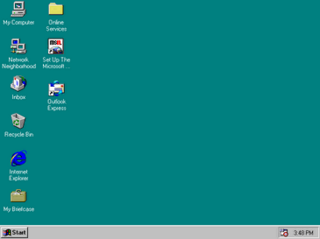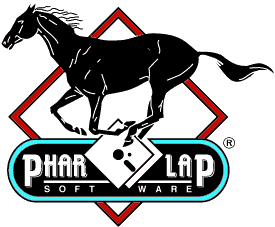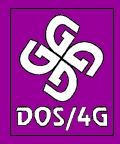Related Research Articles
A terminate-and-stay-resident program is a computer program running under DOS that uses a system call to return control to DOS as though it has finished, but remains in computer memory so it can be reactivated later. This technique partially overcame DOS's limitation of executing only one program, or task, at a time. TSRs are used only in DOS, not in Windows.
Real mode, also called real address mode, is an operating mode of all x86-compatible CPUs. The mode gets its name from the fact that addresses in real mode always correspond to real locations in memory. Real mode is characterized by a 20-bit segmented memory address space and unlimited direct software access to all addressable memory, I/O addresses and peripheral hardware. Real mode provides no support for memory protection, multitasking, or code privilege levels.

In IBM PC compatible computing, DOS memory management refers to software and techniques employed to give applications access to more than 640 kibibytes (KiB) of "conventional memory". The 640 KiB limit was specific to the IBM PC and close compatibles; other machines running MS-DOS had different limits, for example the Apricot PC could have up to 768 KiB and the Sirius Victor 9000, 896 KiB. Memory management on the IBM family was made complex by the need to maintain backward compatibility to the original PC design and real-mode DOS, while allowing computer users to take advantage of large amounts of low-cost memory and new generations of processors. Since DOS has given way to Microsoft Windows and other 32-bit operating systems not restricted by the original arbitrary 640 KiB limit of the IBM PC, managing the memory of a personal computer no longer requires the user to manually manipulate internal settings and parameters of the system.

In DOS memory management, extended memory refers to memory above the first megabyte (220 bytes) of address space in an IBM PC or compatible with an 80286 or later processor. The term is mainly used under the DOS and Windows operating systems. DOS programs, running in real mode or virtual x86 mode, cannot directly access this memory, but are able to do so through an application programming interface called the Extended Memory Specification (XMS). This API is implemented by a driver (such as HIMEM.SYS) or the operating system, which takes care of memory management and copying memory between conventional and extended memory, by temporarily switching the processor into protected mode. In this context, the term "extended memory" may refer to either the whole of the extended memory or only the portion available through this API.

In DOS memory management, expanded memory is a system of bank switching that provided additional memory to DOS programs beyond the limit of conventional memory (640 KiB).

In DOS memory management, conventional memory, also called base memory, is the first 640 kilobytes of the memory on IBM PC or compatible systems. It is the read-write memory directly addressable by the processor for use by the operating system and application programs. As memory prices rapidly declined, this design decision became a limitation in the use of large memory capacities until the introduction of operating systems and processors that made it irrelevant.

Windows 9x was a generic term referring to a series of Microsoft Windows computer operating systems produced from 1995 to 2000, which were based on the Windows 95 kernel and its underlying foundation of MS-DOS, both of which were updated in subsequent versions. The first version in the 9x series was Windows 95, which was succeeded by Windows 98 and then Windows Me, which was the third and last version of Windows on the 9x line, until the series was superseded by Windows XP.
Quarterdeck Expanded Memory Manager (QEMM) is a memory manager produced by Quarterdeck Office Systems in the late 1980s through the late 1990s. It was the most popular third-party memory manager for the MS-DOS and other DOS operating systems.
Virtual DOS machines (VDM) refer to a technology that allows running 16-bit/32-bit DOS and 16-bit Windows programs when there is already another operating system running and controlling the hardware.
CEMM, for Compaq Expanded Memory Manager was the first so-called PC "memory manager" for Intel 80386 CPUs, able to provide expanded memory (EMS) emulation by using the virtual memory features and the virtual 8086 mode of the CPU.
A DOS extender is a computer software program running under DOS that enables software to run in a protected mode environment even though the host operating system is only capable of operating in real mode.

Phar Lap Software, Inc., was a software company specializing in software development tools for DOS operating systems. The company was named after the champion New Zealand racehorse Phar Lap. They were most noted for their software allowing developers to access memory beyond the 640 KiB limit of DOS and were an author of the VCPI standard.
EMM386 is the expanded memory manager of Microsoft's MS-DOS, IBM's PC DOS, Digital Research's DR-DOS, and Datalight's ROM-DOS which is used to create expanded memory using extended memory on Intel 80386 CPUs. There also is an EMM386.EXE available in FreeDOS.

In DOS memory management, the upper memory area (UMA) is the memory between the addresses of 640 KB and 1024 KB (0xA0000–0xFFFFF) in an IBM PC or compatible. IBM reserved the uppermost 384 KB of the 8088 CPU's 1024 KB address space for BIOS ROM, Video BIOS, Option ROMs, video RAM, memory-mapped I/O, and obsoleted ROM BASIC.

DOS/4G is a 32-bit DOS extender developed by Rational Systems. It allows DOS programs to eliminate the 640 KB conventional memory limit by addressing up to 64 MB of extended memory on Intel 80386 and above machines.
The DOS API is an API which originated with 86-DOS and is used in MS-DOS/PC DOS and other DOS-compatible operating systems. Most calls to the DOS API are invoked using software interrupt 21h. By calling INT 21h with a subfunction number in the AH processor register and other parameters in other registers, various DOS services can be invoked. These include handling keyboard input, video output, disk file access, program execution, memory allocation, and various other activities. In the late 1980s, DOS extenders along with the DOS Protected Mode Interface (DPMI) allow the programs to run in either 16-bit or 32-bit protected mode and still have access to the DOS API.
In computing, the Virtual Control Program Interface (VCPI) is a specification published in 1989 by Phar Lap Software that allows a DOS program to run in protected mode, granting access to many features of the processor not available in real mode. It was supplanted by DOS Protected Mode Interface (DPMI) shortly after being introduced, due in large part to VCPI's inability to work in Windows 3.0's protected mode.

DOS is a family of disk-based operating systems for IBM PC compatible computers. The DOS family primarily consists of IBM PC DOS and a rebranded version, Microsoft's MS-DOS, both of which were introduced in 1981. Later compatible systems from other manufacturers include DR-DOS (1988), ROM-DOS (1989), PTS-DOS (1993), and FreeDOS (1998). MS-DOS dominated the IBM PC compatible market between 1981 and 1995.

The Windows 9x series of operating systems used a monolithic kernel to power the inner components of such operating systems. As MS-DOS runs on a monolithic kernel, there is not a lot of different between MS-DOS and Windows 9x.
DOS Protected Mode Services (DPMS) is a set of extended DOS memory management services to allow DPMS-enabled DOS drivers to load and execute in extended memory and protected mode.
References
- 1 2 3 4 5 6 7 Duncan, Ray (1991-02-12). "Power Programming – An Introduction to the DOS Protected Mode Interface". PC Magazine . 10 (3). Ziff-Davis Publishing Co.: 367–371. ISSN 0888-8507 . Retrieved 2016-05-21.
[…] The creators of the VCPI were well aware of its limitations and were already hard at work on a second generation specification called Extended VCPI (XVCPI), when Microsoft barged onto the scene with the beta-test versions of Windows 3.0 and its DPMI. For a few months it appeared that the fledgling DOS extender market would fragment into two mutually exclusive directions […] Microsoft turned control of the DPMI specification over to an industry committee with open membership, and the backers of the XVCPI effort decided to join forces behind the DPMI. […] Microsoft agreed to delete the portions of the DPMI that crossed into DOS extender territory - specifically, direct support of the DOS and ROM BIOS interrupts in protected mode. Consequently, DPMI, Version 0.9, the first public version, released by the DPMI Committee in May 1990, defines only the low-level or building-block functions […] Naturally, the higher level or DOS extender interface of Windows 3.0 still exists, but it has receded into the twilight zone of undocumented functionality. Undocumented, but hardly unusable […]
- ↑ Duncan, Ray; Petzold, Charles; Schulman, Andrew; Baker, M. Steven; Nelson, Ross P.; Davis, Stephen R.; Moote, Robert (1992). Extending DOS: A Programmer's Guide to Protected-Mode DOS. 2 (2 ed.). Addison-Wesley Publishing Company, Inc. pp. 433–436. ISBN 0-201-56798-9.
- ↑ Schmit, Michael L. (1995). Pentium Processor Optimization Tools (1 ed.). Cambridge, Massachusetts, USA: Academic Press, Inc. (AP Professional). ISBN 0-12-627230-1.
- ↑ Microsoft (Fall 1989), DOS Protected Mode Interface Specification, Revision Prerelease 0.04 (Prerelease ed.)
- 1 2 3 4 Cole, Dave (1992-05-04). Neiminen, Bruce (ed.). "Re: MS-DOS DPMI extensions" (PDF) (Court document). Microsoft. pp. 123–124. MSC 00779372/00779373, MX3232616/3232617, Cole Exhibit 10, 2001-06-21. Archived (PDF) from the original on 2018-09-18. Retrieved 2018-09-17– via Comes v. Microsoft - Plaintiff's exhibit 1306.
[…] [Ralph Lipe:] I think, they're checked into Win386 project. In the root MSDOS.DOC (look at all the .DOC files in the root) […] NO! This is an extremely sensitive matter since it basically tells […] ISVs (AKA DR-DOS and IBM) how to run standard mode Windows. You need to clear it with BradSi[lverberg] before distributing it. [Greg Lowney:] SoftNet makes a limulator. They read in the C7 manual that you can run C7 dos-extended if your limulator supports the MS-DOS extensions to the DPMI specification. So […] they called us to get a spec on exactly what those extensions are. Apparently they are not documented. […] They are not that complicated, mostly just what MS-DOS and BIOS calls we map for the application, and Qualitas had no trouble reverse engineering them. (The new 386MAX was, in beta, able to run KRNL386 from the command line, but I believe they disabled that feature in their final product to avoid stepping on our feet. 386MAX does, of course, support C7.) […] Ralph, was the spec distributed to the members of the DPMI committee? […] [Dave Cole:] We should absolutely NOT document this. […]
- ↑ Microsoft (1990-10-31). Sokolov, Michael (ed.). "MS-DOS API EXTENSIONS FOR DPMI HOSTS Version Pre-Release 0.02" (Annotated retyped preliminary ed.) (published 1999-04-08). Retrieved 2016-05-23.
- ↑ Microsoft (1989). Sokolov, Michael (ed.). "DOS PROTECTED MODE INTERFACE (DPMI) – SPECIFICATION Protected Mode API For DOS Extended Applications" (Annotated incompletely reconstructed ed.) (published 1999-04-08). Retrieved 2016-05-23.
- 1 2 3 4 Wurthmann, Gerold; Wopperer, Bernhard; Wiesböck, Johann (1991). "Die DPMI-Spezifikation – Eine Einführung" [An introduction to the DPMI specification]. Vorträge und Begleittexte zum 2. Entwicklerforum der Design & Elektronik zum Thema: PC-Architektur, 17. September 1991, München[Presentations and supplemental material for the second developer forum on PC architecture on 17 September 1991, Munich] (book) (in German) (1 ed.). Munich, Germany: Markt & Technik Verlag Aktiengesellschaft. p. 223. (NB. The forum was organized by the German magazine Design & Elektronik and Intel.)
- ↑ The DPMI Committee (1991-03-12). DOS Protected Mode Interface (DPMI) Specification – Version 1.0 – Application Program Interface (API) for Protected Mode DOS Applications (PDF). 1.0. Intel. pp. 4–5. Intel order code 240977-001. Archived from the original (PDF) on 2013-05-31. Retrieved 2013-05-24.
The initial DPMI prototype was developed by Microsoft for Windows version 3.0, with input from Lotus Corporation and Rational Systems, as part of a general effort to enhance Windows' performance by allowing the Windows kernel to run in extended memory. In parallel, Intel was working with manufacturers of multitasking environments, EMS emulators, and DOS extenders to ensure that an extended VCPI specification could fully utilize the 80386's virtualization and protection features. In February 1990, the parties involved in the above activities agreed to form the DPMI Committee and formulate an industry-wide standard for protected-mode DOS applications. The Committee released the first public DPMI Specification, Version 0.9 in May 1990.
- 1 2 3 Schneider, Stefanie (1994-06-17). "Das Ende von DOS ist nur noch eine Frage der Zeit" [The end of DOS is only a question of time]. Computerwoche (in German). Munich, Germany: IDG Business Media GmbH. Archived from the original on 2022-01-02. Retrieved 2022-01-02.
- ↑ "FILE: Windows Int 21h and NetBIOS Support for DPMI". Knowledge Base. Microsoft. 2004-08-04 [1999-12-04]. KB65128. Q65128. Archived from the original on 2020-02-20. Retrieved 2016-05-21.
- ↑ Sokolov, Michael (1998-05-06). "lA correction to a previous posting". lynx-dev. Archived from the original on 2020-02-20. Retrieved 2020-02-20.
- ↑ Schulman, Andrew; Brown, Ralf D.; Maxey, David; Michels, Raymond J.; Kyle, Jim (1994) [November 1993]. Undocumented DOS: A programmer's guide to reserved MS-DOS functions and data structures - expanded to include MS-DOS 6, Novell DOS and Windows 3.1 (2 ed.). Reading, Massachusetts, USA: Addison Wesley. p. 194. ISBN 0-201-63287-X. (xviii+856+vi pages, 3.5"-floppy) Errata: